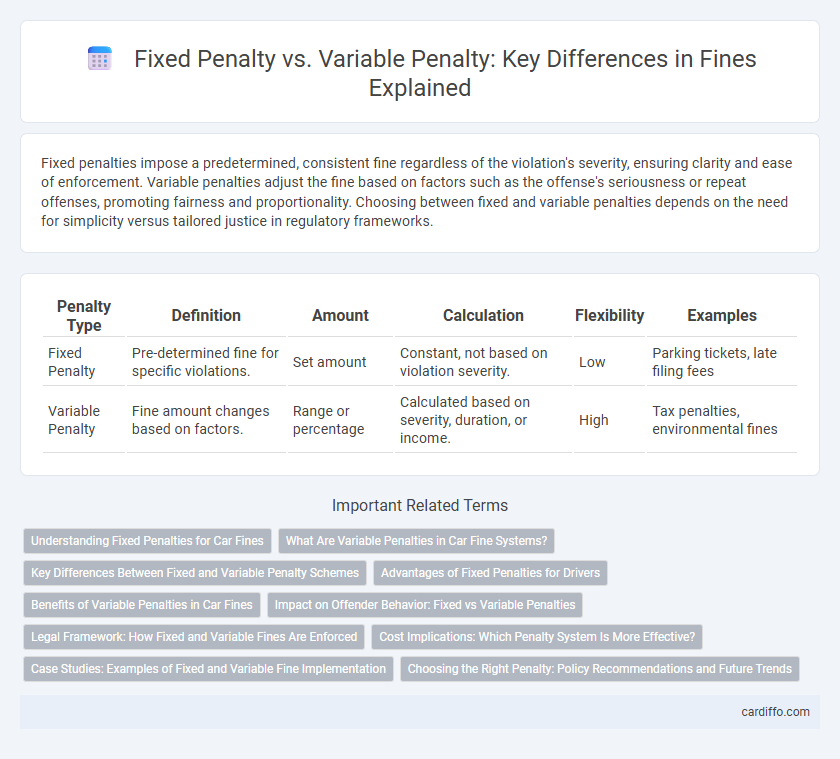Fixed penalties impose a predetermined, consistent fine regardless of the violation's severity, ensuring clarity and ease of enforcement. Variable penalties adjust the fine based on factors such as the offense's seriousness or repeat offenses, promoting fairness and proportionality. Choosing between fixed and variable penalties depends on the need for simplicity versus tailored justice in regulatory frameworks.
Table of Comparison
| Penalty Type | Definition | Amount | Calculation | Flexibility | Examples |
|---|---|---|---|---|---|
| Fixed Penalty | Pre-determined fine for specific violations. | Set amount | Constant, not based on violation severity. | Low | Parking tickets, late filing fees |
| Variable Penalty | Fine amount changes based on factors. | Range or percentage | Calculated based on severity, duration, or income. | High | Tax penalties, environmental fines |
Understanding Fixed Penalties for Car Fines
Fixed penalties for car fines involve a predetermined, non-negotiable amount set by traffic authorities, designed to streamline the enforcement process and provide clear expectations for drivers. These penalties apply to specific violations such as speeding within a certain range or parking infractions, ensuring consistency and efficiency in managing traffic offenses. Understanding fixed penalties helps drivers quickly resolve minor violations without court proceedings, minimizing legal complexity and administrative costs.
What Are Variable Penalties in Car Fine Systems?
Variable penalties in car fine systems adjust the amount of the fine based on specific factors such as the severity of the violation, the driver's history, or the vehicle type. Unlike fixed penalties, which impose a set amount regardless of circumstances, variable fines can increase or decrease, optimizing enforcement fairness and deterrence. This approach encourages safer driving behaviors by aligning penalties more closely with the risk and impact of each offense.
Key Differences Between Fixed and Variable Penalty Schemes
Fixed penalty schemes impose a predetermined fine amount regardless of the severity or frequency of the violation, ensuring straightforward enforcement and predictability. Variable penalty schemes adjust the fine based on factors such as the nature of the offense, offender's history, or financial status, promoting fairness and deterrence tailored to individual circumstances. The key difference lies in fixed penalties offering simplicity and consistency, while variable penalties provide flexibility and nuanced justice.
Advantages of Fixed Penalties for Drivers
Fixed penalties offer drivers clear, predictable fines that simplify financial planning and reduce stress. These penalties encourage timely resolution of traffic violations without prolonged disputes, fostering smoother legal processes. By providing standardized consequences, fixed penalties promote fairness and consistency across all driving offenses.
Benefits of Variable Penalties in Car Fines
Variable penalties in car fines offer a tailored approach that aligns the severity of the fine with the nature of the violation, promoting fairness and proportionality in traffic enforcement. By adjusting fines based on factors such as speed excess or repeat offenses, variable penalties incentivize safer driving behavior and reduce the likelihood of reckless driving. This flexible system enhances compliance, improves road safety, and generates more accurate deterrents compared to fixed penalty schemes.
Impact on Offender Behavior: Fixed vs Variable Penalties
Fixed penalties provide clear and consistent consequences, leading to predictable offender behavior and potentially higher compliance rates. Variable penalties introduce uncertainty and can deter offenses through the fear of harsher sanctions, promoting behavioral adaptation. Research indicates that variable penalties may better incentivize offenders to avoid violations, as the unpredictability of consequences increases perceived risk.
Legal Framework: How Fixed and Variable Fines Are Enforced
Fixed penalties are typically enforced through predetermined statutory rates outlined in specific legislation, ensuring consistent application across similar offenses. Variable fines depend on judicial discretion, allowing courts to assess the severity of an infraction and the offender's circumstances to determine the appropriate amount. Enforcement mechanisms for both include administrative notices, court summons, and potential escalation to higher penalties if unpaid within designated timeframes.
Cost Implications: Which Penalty System Is More Effective?
Fixed penalties offer predictable cost implications by imposing a set fine regardless of the offense severity, making budget forecasting straightforward for organizations and governments. Variable penalties adjust fines based on factors like violation gravity or offender income, potentially enhancing fairness but introducing complexity in cost estimation and enforcement resources. Effectiveness depends on balancing administrative efficiency with deterrence impact, where fixed penalties simplify costs but variable penalties may better align financial consequences with offense seriousness.
Case Studies: Examples of Fixed and Variable Fine Implementation
Case studies reveal that fixed penalty systems, such as London's congestion charge, consistently enforce uniform fines for violations to streamline compliance and reduce administrative costs. Variable fine models, exemplified by Sweden's graduated speeding tickets, adjust penalties based on offense severity or income, enhancing fairness and deterrence. Comparative analysis shows variable penalties often lead to greater behavioral modification, while fixed penalties provide predictability and simplified enforcement.
Choosing the Right Penalty: Policy Recommendations and Future Trends
Choosing the right penalty structure involves analyzing the context and objectives of enforcement policies, where fixed penalties offer clarity and predictability, while variable penalties provide flexibility and proportionality. Policy recommendations emphasize utilizing variable penalties in sectors with diverse violations to enhance fairness and compliance, supported by data-driven frameworks that adapt to offender behavior. Future trends indicate increased integration of AI and machine learning to optimize penalty decisions, balancing deterrence with rehabilitation and cost-efficiency.
Fixed penalty vs variable penalty Infographic

 cardiffo.com
cardiffo.com